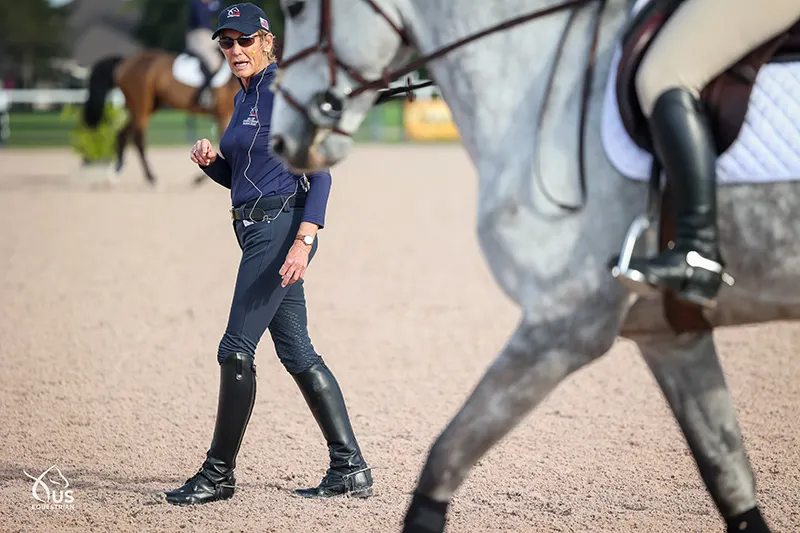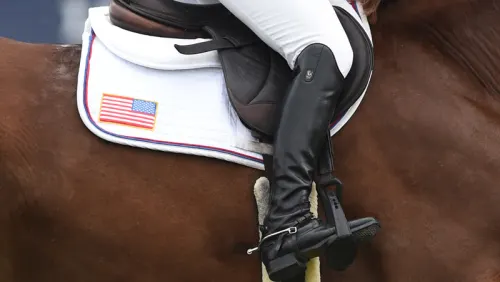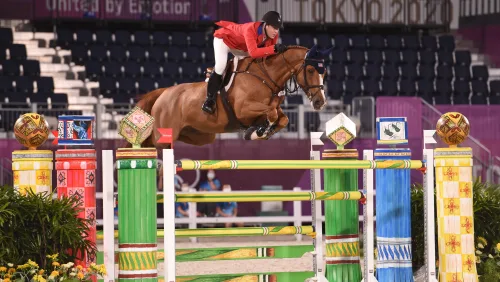The annual USEF Horsemastership Training Series began Friday with a flatwork session taught by Olympic show jumper Anne Kursinski in which she emphasized the importance of dressage work for show jumpers, and the importance of patience in training and communicating with horses.
Twelve riders were invited to participate in the three-day clinic, which runs Jan. 7-9 at the Equestrian Village in Wellington, Florida, based on their results at U.S. Jumping Pathways Programs or being offered wild-card spots.

Olympic show jumper Anne Kursinski started the first day of the 2022 USEF Horsemastership Training Series with a flatwork demonstration ride on a young horse. Taylor Pence/USEF Photos
Kursinski started the session by talking about the importance of schooling horses in basic dressage movements. She incorporated many lateral exercises into the sessions, including shoulder-in and haunches-in, leg-yield, half-pass, turns on the forehand or haunches, and lengthening or shortening strides at all gaits. Riders should be physically fit, she said, so they can use their whole body to help their horse.
Kursinski was very encouraging and patient if the young riders had difficulty executing the movements during their session. Here are five take-aways from this morning’s first two mounted flatwork sessions:
1. Always be patient with your horse. Kursinski started the morning off with a demonstration ride on Bernie, a green 7-year-old gelding in her barn. About halfway through the ride, Kursinski asked Bernie to lengthen at the posting trot down the diagonal, and he mistakenly started to canter. Kursinski remained calm and did not change her centered position.
“So here in the corner, I’ll bring him back to the trot,” she explained through her microphone, “and then I’ll ask again down the next long side. It’s not a war; I’m not fighting with him. I’m trying to educate him on what I want, and sometimes that requires a bit of patience on the rider’s part.”
Kursinski also emphasized the importance of believing in your horse and trusting that he can do what you’re asking.
“Your mindset will affect him, too,” she said. “You must trust that he will figure it out and not fight him if he gets confused. The sign of a great rider is a happy horse.”
2. Your leg is the most important aid. Kursinski was adamant about riders using their legs more than their hands through every movement, even during their downward transitions.
ADVERTISEMENT
“Your horse’s engine is in his hind legs,” Kursinski explained to the young riders. “When your horse comes above the bit or resists contact, push him forward from your leg into your hand. It’s not about pulling their head down into a frame. Send them forward and straight into your hand so they take the bit and accept contact.”
During their sessions, Kursinski was quick to correct when riders went to their hands instead of their legs, especially in their lateral exercises. “Remember, it’s a leg-yield, not a rein-yield.”

Kursinski worked with 12 promising young riders who were invited to the annual training session, being held Jan. 7-9 in Wellington, Florida.
3. Your riding position affects your communication with your horse. Throughout the two mounted sessions, Kursinski emphasized the importance of riders being aware of their body position.
“If you cannot control your own position, you will have difficulty controlling the horse,” she repeated several times. “The straighter your position stays, the more clearly you can communicate to your horse. You don’t want to be creating a problem with your horse so that he’s compensating for your poor position.”
She also encouraged riders to allow their hips to follow the direction of where the horse is going, especially in lateral movements like half-pass, leg-yield and counter-canter.
“If you twist the opposite way, you’ll give your horse the wrong message and he won’t understand what you are asking. Because of this, he may not be able to correctly execute the movement.”
4. Short reins and long, following arms allow for quick corrections. In both sessions, Kursinski had the young riders make a knot in their reins so they could feel how to use their hands as a pair and maintain steady contact with the horse’s mouth. She wanted the riders to feel how to be relaxed in their elbows and arms, not opening their fingers in order to be soft.
“A horse’s mouth is roughly 5 to 5 ½ inches wide. That’s how far your hands should be apart from one another,” Kursinski said. “Your reins should be short so you can quickly correct any mistakes or miscommunications. You should also carry your hands just above the horse’s withers, not down near his neck.”
The riders performed lateral work without stirrups, as well as lengthening and collecting the walk, trot and canter, with the knot in their reins.
ADVERTISEMENT
When Kursinski allowed a short walk break, she asked the riders what they thought of riding with the knot in their reins.
Participant Mimi Gochman said she was able to keep her hands steadier, and she felt she could focus more on using her legs to push the horse forward. Carlee McCutcheon echoed Gochman, saying she felt she could keep a better connection with her horse. Kursinski was pleased that the riders could feel a difference.
“Feeling your horse is not just black and white,” Kursinski said. “When you ride, you’re carrying on a whole conversation with your horse through your aids.”
5. Be diligent in your flatwork. At the end of the first mounted session, Kursinski explained that a lot of the top European show jumpers train with a dressage rider because they understand the importance of correct flatwork for their horses.
“Billy Steinkraus always used to say, ‘A lot of the problems in jumping horses can be fixed on the flat,’ ” Kursinski said during her demonstration ride. “The best riders in the world look like they aren’t doing anything in the saddle. That’s because their horses are so tuned on the flat that they don’t need to overuse their aids.”
Proper flatwork helps develop a horse’s rideability, and it also helps the rider evaluate their own effectiveness.
“It’s like going to the gym or working with a physical therapist: an exercise might be hard at first, but you don’t give up immediately,” Kursinski said. “You work at it slowly. Just like you don’t always love doing all the exercises at the gym, the horses don’t either. You have to encourage them to keep going.”
The 2022 Horsemastership Training Series continues Jan. 8 with gymnastics sessions led by Olympian Lauren Hough, and coursework sessions Jan. 9 with Olympian Laura Kraut. The sessions are being livestreamed on USEF Network.














